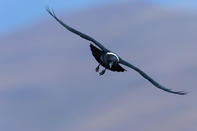
Name
Pied Crow (Corvus albus)Pied Crow Appearance
Both sexes are alike with a black head, neck and upper breast. The wings and tail are uniform black. The pied crow has a white collar on its upper mantle, extending to the breast and sides of the body. Legs and feet are black. The eyes are dark brownDiet
The pied crow is omnivorous, but its diet is mainly plant-based and will include fruit, seeds, roots, lizards, small mammals, snakes, birds, eggs and fish. It will also scavenge at a carcass.Pied Crow Breeding
The pied crow is monogamous. Both sexes build a large bowl-like nest out of sticks in an isolated tree. Two to three eggs are laid and are incubated by both parents for around 18 days, the young crows fledge at 30 to 40 days. The pied crow is a host of the greater spotted cuckoo.Behaviour
Normally found in pairs, but will flock in non-breeding times of the year. Big flocks of up to 300 birds have been recorded.Pied Crow Distribution and Habitat
The pied crow is found throughout South Africa. Occurring in most habitats, but not in the very arid regions of the southern Kalahari and the Karoo. The pied crow is rarely seen far from human settlements.
The pied crow numbers and distribution is increasing, mainly in parts of the Western Cape and into the Karoo. Recent studies have suggested that this is due to global warming and addition nesting sites.
Pied crows are tree nesters and with the expansion of the electrical supply, the crows are using the electrical infrastructure of the power lines to nest. With global warming, the climate has warmed in the arid midwest of South Africa and cooled in the north-east, opening new habitats for the crows.